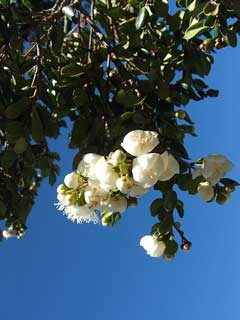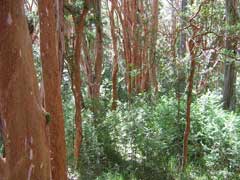 |
|
|
 |
| http://commons.wikimedia.org/wiki/User:Alfonso%22 |
Translate this page:
Summary
Physical Characteristics

 Luma apiculata is an evergreen Shrub growing to 6 m (19ft) by 4 m (13ft) at a medium rate.
Luma apiculata is an evergreen Shrub growing to 6 m (19ft) by 4 m (13ft) at a medium rate.
See above for USDA hardiness. It is hardy to UK zone 9 and is frost tender. It is in leaf all year, in flower from July to October, and the seeds ripen from October to November. The species is hermaphrodite (has both male and female organs) and is pollinated by Bees. The plant is self-fertile.
Suitable for: light (sandy), medium (loamy) and heavy (clay) soils and prefers well-drained soil. Suitable pH: mildly acid, neutral and basic (mildly alkaline) soils. It cannot grow in the shade. It prefers moist soil. The plant can tolerate maritime exposure.
UK Hardiness Map
US Hardiness Map
Synonyms
Eugenia apiculata. Myrceugenella apiculata. Myrceugenia apiculata. Myrtus apiculata. Mol. Myrtus lum
Plant Habitats
Woodland Garden Sunny Edge; Dappled Shade; Hedge;
Edible Uses
Edible Parts: Fruit
Edible Uses:
Fruit - raw or cooked[3, 105, 177]. A sweet flavour[1]. The flavour and texture can vary considerably from plant to plant, the best are juicy, succulent, sweet and aromatic with a delicious taste, though the fruit can be dry and almost tasteless. The fruit is usually borne abundantly in Cornwall[K]. The fruit is about 10mm in diameter[200].
References More on Edible Uses
Medicinal Uses
Plants For A Future can not take any responsibility for any adverse effects from the use of plants. Always seek advice from a professional before using a plant medicinally.
None known
References More on Medicinal Uses
The Bookshop: Edible Plant Books
Our Latest books on Perennial Plants For Food Forests and Permaculture Gardens in paperback or digital formats.

Edible Tropical Plants
Food Forest Plants for Hotter Conditions: 250+ Plants For Tropical Food Forests & Permaculture Gardens.
More

Edible Temperate Plants
Plants for Your Food Forest: 500 Plants for Temperate Food Forests & Permaculture Gardens.
More

More Books
PFAF have eight books available in paperback and digital formats. Browse the shop for more information.
Shop Now
Other Uses
References More on Other Uses
Cultivation details
Succeeds in any reasonably good soil[1] but prefers a moderately fertile well-drained loam in a sunny position[11, 200]. A very ornamental plant[1], it does not succeed outside the milder areas of Britain[3] but when fully dormant it is hardy to -10°c in warm maritime gardens[184, 200]. The young growth in spring can be damaged by late frosts. This species grows well in Cornwall where it often self-sows[11, 49, 59, 166]. Plants are fairly tolerant of maritime exposure but they dislike cold drying winds[49, 166] and flower best when growing in a sheltered position. The leaves are very aromatic[188]. The fragrant white flowers are borne in great profusion[245].
References Carbon Farming Information and Carbon Sequestration Information
Temperature Converter
Type a value in the Celsius field to convert the value to Fahrenheit:
Fahrenheit:
The PFAF Bookshop
Plants For A Future have a number of books available in paperback and digital form. Book titles include Edible Plants, Edible Perennials, Edible Trees,Edible Shrubs, Woodland Gardening, and Temperate Food Forest Plants. Our new book is Food Forest Plants For Hotter Conditions (Tropical and Sub-Tropical).
Shop Now
Plant Propagation
Pre-soak the seed for 24 hours in warm water and then sow in late winter in a greenhouse. When they are large enough to handle, prick the seedlings out into individual pots and grow them on in the greenhouse for at least their first winter. Plant them out into their permanent positions in late spring or early summer, after the last expected frosts. Cuttings of half-ripe wood, 7 - 10cm with a heel, July/August in a frame. Pot up in the autumn and overwinter in a cold frame. Plant out in late spring. High percentage[78]. Cuttings of mature wood, 7 - 12cm with a heel, November in a shaded and frost free frame. Plant out in late spring or early autumn. High percentage[78]. Layering.
Other Names
If available other names are mentioned here
Arrallan, Arrayan, Palo colorado, Palo rojo, Temu,
Native Range
SOUTHERN AMERICA: Argentina (Chubut, Neuquén, Río Negro), Chile
Weed Potential
Right plant wrong place. We are currently updating this section.
Please note that a plant may be invasive in one area but may not in your area so it's worth checking.
Conservation Status
IUCN Red List of Threatened Plants Status :

Growth: S = slow M = medium F = fast. Soil: L = light (sandy) M = medium H = heavy (clay). pH: A = acid N = neutral B = basic (alkaline). Shade: F = full shade S = semi-shade N = no shade. Moisture: D = dry M = Moist We = wet Wa = water.
Now available:
Food Forest Plants for Mediterranean Conditions
350+ Perennial Plants For Mediterranean and Drier Food Forests and Permaculture Gardens.
[Paperback and eBook]
This is the third in Plants For A Future's series of plant guides for food forests tailored to
specific climate zones. Following volumes on temperate and tropical ecosystems, this book focuses
on species suited to Mediterranean conditions—regions with hot, dry summers and cool, wet winters,
often facing the added challenge of climate change.
Read More
Expert comment
Author
(DC.)Burret.
Botanical References
11200
Links / References
For a list of references used on this page please go here
Readers comment
© 2010, Plants For A Future. Plants For A Future is a charitable company limited by guarantee, registered in England and Wales. Charity No. 1057719, Company No. 3204567.